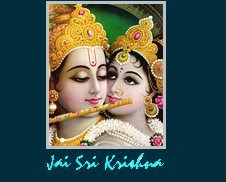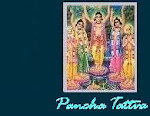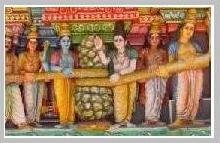
Figures of Speech
With Examples From Vedic literature
Part I
* * * * *
*
Simile
Definition - a simile is a comparison of one thing with another of a different kind.
An example of a simile is found in Srimad Bhagawatam (1-1-3) where the narrator, Suta Goswami says: “Please know it that Srimad Bhagawatam is the mature fruit of the desire tree of Vedic literature.” There are two similes here: Srimad Bhawatam is compared to the mature fruit, and Vedic literature is compared to the desire tree.
An example of a simile is found in Srimad Bhagawatam (1-1-3) where the narrator, Suta Goswami says: “Please know it that Srimad Bhagawatam is the mature fruit of the desire tree of Vedic literature.” There are two similes here: Srimad Bhawatam is compared to the mature fruit, and Vedic literature is compared to the desire tree.
Another example of simile is found in Sri Brahama Vivanta Purana, where Krishna is described: “His lips splendid like ripe bimba fruit and His handsome teeth like ripe pomegranate seeds.”
* * *
Metaphor
Definition - a metaphor is an application of a term or phrase to which it is not literally applicable.
An example of metaphor is found in Srimad Bhagawatam (1-1-14) wherein Shaunaka Rishi chief of the Sages at Naimisaranya says, “Living beings who are entangled in the hurdle of birth and death can get freedom at once even by unconsciously chanting the Holy Name of Krishna.” Here hurdle is used as a metaphor.
An example of metaphor is found in Srimad Bhagawatam (1-1-14) wherein Shaunaka Rishi chief of the Sages at Naimisaranya says, “Living beings who are entangled in the hurdle of birth and death can get freedom at once even by unconsciously chanting the Holy Name of Krishna.” Here hurdle is used as a metaphor.
Another example of a metaphor is found in Sri Brahma Vivarta Purana. The demigods first see Krishna in the form He assumes as light.. The light is described as a “light that robs all other lights of their splendor.” Robs is used here as a metaphor.
* * *
Analogy
Definition - An analogy is a correspondence or a partial similarity.
An example of analogy is found in Sri Brahma Vivarta Purana, where Lord Brahma prays to Lord Krishna: May the bumble bee of my mind always lovingly stay at the lotus flower of your feet.” (this verse also contains two similes.)
***
Ambiguity
Definition - Ambiguity is having an obscure or double meaning.
An example of ambiguity is found in Sri Lalita Madhava, Act Nine verse one wherein Nava Vrinda says: Nava-vrnda: (looks ahead and says with joy) Purifying the waters of the streams and lakes, expertly revealing the sweetness of the moon, and filling the regal swans with happiness, Sarat, the goddess of autumn, who is like goddess Bhakti-devi herself, has now come before us.
Note: If the word “bhuvana” is interpreted to mean “the world,” “vidhu” to mean “Lord Krsna” and “paramahamsa” to mean “the swanlike devotees,” the verse may be interpreted in the following way; “Purifying the world, expertly revealing the sweetness of Lord Krsna, and filling the swanlike devotees with happiness, goddess Bhakti-devi, appearing as the autumn season, has now come before us.”
***
Innuendo
Definition - innuendo is an allusion remark or hint usually disparaging.An example of innuendo is found in Sri Vidagdha-Madhava, Act two, text 52- B. Krishna wants to engage in pastimes with Radha, but Jatila, who is the mother of Abhimanyu, appears there and disturbs the mood. Krishna uses innuendo with this analogy: “Just as the cakora bird is about to drink the moonlight, a mass of clouds covers the crescent moon.
***
Sarcasm
Definition - sarcasm is a bitter or wounding remark, a taunt that is ironically worded.An example of sarcasm is found in Sri Vidagdha-Madhava, Act two, text 53-A. Jatila says to Krishna, “Charming boy. Don’t look at the young gopis with such crooked eyes.” Madhu Mangal says: O lady, hard like Indra’s thunderbolt, my dear friend’s glance is always charming and gentle. It is you whose eyes are squinting. Therefore, you should grant a benediction to yourself, that your eyes do not squint. Here, both the remarks of Jatila and Madhu Mangal are sarcastic.
***
Parody
Definition - parody is an exaggerated imitation of an author, literary work, style, etc.
An example of parody is found in Bhagavad - Gita Ch. 16 texts 13-15, wherein Krishna imitates the talk of a demoniac person. The demoniac person thinks: “So much wealth do I have today, and I will gain more according to my schemes. So much is mine now, and it will increase in the future, more and more. He is my enemy, and I have killed him; and my other enemy will also be killed. I am the lord of everything, I an the enjoyer, I am perfect, powerful and happy. I am the richest man, surrounded by aristocratic relatives. There is none so powerful and happy as I am. I shall perform sacrifices, I shall give some charity, and thus I shall rejoice.”
An example of parody is found in Bhagavad - Gita Ch. 16 texts 13-15, wherein Krishna imitates the talk of a demoniac person. The demoniac person thinks: “So much wealth do I have today, and I will gain more according to my schemes. So much is mine now, and it will increase in the future, more and more. He is my enemy, and I have killed him; and my other enemy will also be killed. I am the lord of everything, I an the enjoyer, I am perfect, powerful and happy. I am the richest man, surrounded by aristocratic relatives. There is none so powerful and happy as I am. I shall perform sacrifices, I shall give some charity, and thus I shall rejoice.”
***
Satire
Definition - satire usually implies the use of sarcasm or irony for the purpose of ridicule or criticism to expose the folly or lampoon individual.
An example of satire is found in Sri Vidadha-Madhava, Act two, text 37. Lalita says: “Krishna does not give up His beautiful loving smiles which is full of cheating tricks. O, Srimati Radharani you are very intelligent. How could you have developed such great loving affection for this deceitful debauchee from the neighborhood of the cowboys.”
An example of satire is found in Sri Vidadha-Madhava, Act two, text 37. Lalita says: “Krishna does not give up His beautiful loving smiles which is full of cheating tricks. O, Srimati Radharani you are very intelligent. How could you have developed such great loving affection for this deceitful debauchee from the neighborhood of the cowboys.”
***
Irony
Definition - Irony is humorous or sarcastic use of language of a different or opposite meaning. Irony is the humor that is implicit in the contradiction between what is meant and what is expressed.
An example of irony is found in the Mahabharata. During the battle of Kurukshetra, some Kuru soldiers tried to encourage Duryodhana. They told him that the Kurus would be victorious, but actually they were convinced that because Krishna was on the side of the Pandava, the Pandavas would be victorious..
An example of irony is found in the Mahabharata. During the battle of Kurukshetra, some Kuru soldiers tried to encourage Duryodhana. They told him that the Kurus would be victorious, but actually they were convinced that because Krishna was on the side of the Pandava, the Pandavas would be victorious..
***
Fable
Definition - Fable is a supernatural story not based on fact. It is synonymous with parable and allegory. It usually teaches a lesson.
An example of fable is found in Srimad Bhagawatam, Canto four, chapters 25-28, which is the story of king Puranjana, who represents the living entity who tries to enjoy in the city of nine gates.
An example of fable is found in Srimad Bhagawatam, Canto four, chapters 25-28, which is the story of king Puranjana, who represents the living entity who tries to enjoy in the city of nine gates.
***
Euphemism
Definition - Euphemism is a mild or vague expression substituted for a harsher more direct one.An example of euphemism took place in a room conversation at 26 Second Avenue in 1968. Hansadutta asked Srila Prabhupad when he (Hansadutta) could start taking Sankirtan around the world. Srila Prabhupada told him: “first get the horses, then get the whip.”
***
Hyperbole
Definition - Hyperbole is an exaggerated statement - not meant to be take on literally.
An example of hyperbole is found in Jaiva Dharma, Ch. 37, page 803 Gosvami said: Once, when Krsna was returning to His home after spending time with Srimati Radha, He suddenly met with Candravali. Sri Krishna inquired from her, “O Radhe, is everything fine with you?” When Candravali heard Krsna speaking like this, she replied rather angrily, “O Kamsa, are You well?”
An example of hyperbole is found in Jaiva Dharma, Ch. 37, page 803 Gosvami said: Once, when Krsna was returning to His home after spending time with Srimati Radha, He suddenly met with Candravali. Sri Krishna inquired from her, “O Radhe, is everything fine with you?” When Candravali heard Krsna speaking like this, she replied rather angrily, “O Kamsa, are You well?”
***
Paradox
Definition - Paradox is a statement that appears to be contradictory but expresses some measure of the truth.
An example of paradox is found in Sri Isopanisad, mantra twelve: “those who are engaged in the worship of demigods enter into the region of ignorance, and still more so do the worshippers of the Absolute.” It is explained in the purport that the worshippers of the Absolute refer to the pseudo religionists. They use the garb of devotional service to imitate religion, but maintain material affection. They mislead others, and after their spiritual mastership business is over, go the darkest regions of ignorance.
An example of paradox is found in Sri Isopanisad, mantra twelve: “those who are engaged in the worship of demigods enter into the region of ignorance, and still more so do the worshippers of the Absolute.” It is explained in the purport that the worshippers of the Absolute refer to the pseudo religionists. They use the garb of devotional service to imitate religion, but maintain material affection. They mislead others, and after their spiritual mastership business is over, go the darkest regions of ignorance.
***
Oxymoron
Definition - Oxymoron is the combination of words that have contradictory or sharply incongruous meanings.An example of oxymoron is found in Sri Isopanisad, mantra Five:“The Supreme Lord walks and does not walk. He is far away but he is very near as well. He is within everything and again he is outside of everything.”


















